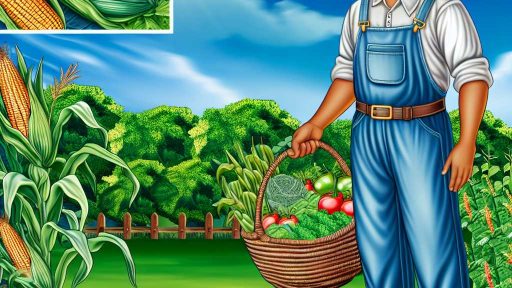Understanding Community Supported Agriculture and its Importance in Crop Selection
Defining Community Supported Agriculture
Community Supported Agriculture connects consumers with local farmers.
This model allows individuals to support local farms by purchasing shares of harvests.
In return, members receive fresh produce throughout the growing season.
Benefits of Community Supported Agriculture
CSAs promote local economies by keeping money within the community.
They also foster relationships between farmers and consumers.
Members often receive high-quality, seasonal produce that is harvested at peak freshness.
Challenges in Crop Selection
Farmers must consider various factors when selecting crops.
These include climate, soil quality, and consumer preferences.
Additionally, farmers need to account for potential pests and diseases.
Crop Diversity and Resilience
Diversifying crops is a key strategy for CSAs.
This approach minimizes risks associated with crop failures.
Moreover, it caters to diverse tastes within the community.
Seasonal Considerations
Seasonality plays a crucial role in crop selection.
Farmers should choose crops that thrive in local climate conditions.
Monitoring weather patterns can help anticipate planting and harvesting times.
Transform Your Agribusiness
Unlock your farm's potential with expert advice tailored to your needs. Get actionable steps that drive real results.
Get StartedEngaging the Community
Involving the community in crop selection enhances CSA success.
Surveys and feedback sessions can gather member preferences.
This interaction builds a sense of ownership among CSA members.
Connecting with Local Trends
Farmers should stay informed about local food trends.
Understanding what crops are in demand can drive business decisions.
Participating in farmers’ markets also provides insights into community preferences.
Effective Crop Selection for Community Supported Agriculture
Effective crop selection is vital for the success of CSAs.
By understanding both community needs and environmental factors, farmers can thrive.
Ultimately, this leads to a sustainable relationship between farmers and consumers.
Assessing Soil Conditions and Climate Variability for Effective Crop Choices
Understanding Soil Health
Healthy soil is essential for productive farming.
Begin by testing the soil composition and pH levels.
Consider organic matter content as well.
Utilize soil amendments to enhance nutrient availability.
Regular testing helps monitor soil health over time.
Evaluating Soil Drainage
Drainage affects crop growth significantly.
Examine the natural drainage patterns in your fields.
Identify areas prone to waterlogging or erosion.
Implement drainage solutions if necessary.
Choose crops that thrive in your specific drainage conditions.
Analyzing Climate Conditions
Climate influences crop selection drastically.
Collect data on temperature patterns throughout the year.
Monitor rainfall amounts and distribution across seasons.
Consider both average conditions and extremes, such as drought or frost.
Adapt your choices based on climate predictions and trends.
Showcase Your Farming Business
Publish your professional farming services profile on our blog for a one-time fee of $200 and reach a dedicated audience of farmers and agribusiness owners.
Publish Your ProfileSelecting Appropriate Crops
After assessing soil and climate, choose suitable crops.
Consider growing crops with complementary growing seasons.
Utilize native plants that require minimal input and maintenance.
Mix crop varieties to enhance biodiversity.
Experiment with cover crops to improve soil structure.
Leveraging Technology and Resources
Employ technology to aid in your assessments.
Use soil sensors to monitor conditions continuously.
Access climate prediction models to inform your strategies.
Engage with agricultural extension services for expert advice.
Networking with local farmers can provide valuable insights.
Identifying Local Market Demands and Consumer Preferences for Crop Selection
Understanding Local Market Dynamics
First, analyze the local agricultural market.
Identifying existing trends informs your crop choices.
Take note of popular crops in nearby farmers’ markets.
Gather data from other community-supported agriculture (CSA) programs.
Consider engaging with local agricultural extensions.
Conducting Consumer Surveys
Surveying consumers provides invaluable insights.
Create concise surveys for your target audience.
Ask about preferred crops and their purchasing behaviors.
Offer incentives for survey completion to increase participation.
Analyze responses to determine the most attractive crops.
Utilizing Social Media for Insights
Leverage social media to understand preferences.
Monitor local food groups and forums.
Engage in discussions to gather real-time feedback.
Share posts asking for crop preferences and ideas.
Use polls to gauge interest in specific crops.
Networking with Local Chefs and Restaurants
Local chefs can share valuable insights on demand.
Reach out to them to discuss ingredient preferences.
Ask about seasonal dishes they commonly prepare.
This information helps align your offerings with culinary trends.
Consider developing partnerships to supply local restaurants.
Analyzing Seasonal Demand Fluctuations
Monitor seasonal patterns to adjust your crop selection.
Understand which crops perform well at different times of the year.
Identify peak seasons for demand in your area.
Use this knowledge to plan your planting schedules accordingly.
This strategy maximizes sales and minimizes waste.
Building Relationships with Your Community
Building community relationships strengthens your CSA program.
Participate in local events and workshops.
Engage with local schools and community organizations.
Listen to their needs and preferences regarding crops.
This interaction nurtures loyalty and increases membership.
Showcase Your Farming Business
Publish your professional farming services profile on our blog for a one-time fee of $200 and reach a dedicated audience of farmers and agribusiness owners.
Publish Your ProfileFind Out More: Water Conservation Tips for Small Farm Success
Incorporating Crop Rotation and Biodiversity for Sustainable Farming Practices
Understanding Crop Rotation
Crop rotation involves alternating the types of crops grown in a specific area.
This technique prevents soil depletion, as different crops use different nutrients.
Moreover, it helps break pest and disease cycles.
Farmers can achieve higher yields and healthier soils through effective rotations.
For instance, legumes can improve soil nitrogen levels when planted after cereals.
Benefits of Biodiversity
Biodiversity enhances the resilience of farming systems.
Diverse crop varieties can withstand pests, diseases, and climate variability better.
Additionally, biodiversity supports a wider range of ecosystem services.
Healthy ecosystems improve pollination, pest control, and soil health.
This interconnectedness fosters a more sustainable agricultural environment.
Implementing Crop Rotation Strategies
Farmers should consider seasonal variations when planning rotations.
Cool-season and warm-season crops can be alternated effectively.
Furthermore, including cover crops can enhance soil structure and fertility.
Cover crops, such as clover or rye, also suppress weeds.
Encouraging On-Farm Biodiversity
On-farm biodiversity can include various plant and animal species.
Crop diversity allows farmers to cater to different market demands.
Moreover, integrating livestock into crop production systems can be beneficial.
This practice promotes nutrient cycling and reduces reliance on chemical fertilizers.
Monitoring and Adjusting Practices
Regular monitoring allows farmers to assess their crop rotation and biodiversity strategies.
Documenting changes in soil health and crop productivity is essential.
Farmers can adjust their practices based on these observations.
Engaging with agricultural advisors can provide valuable insights.
Community and Knowledge Sharing
Collaboration with local farming communities promotes knowledge exchange.
Farmers can learn from each other’s successes and challenges in crop management.
Workshops, field days, and local cooperatives can facilitate this learning process.
Additionally, engaging with universities can provide access to research and innovations.
Learn More: Local Food Sourcing Benefits for Community Farms
Utilizing Data Analytics and Past Harvest Performance to Inform Crop Decisions
The Importance of Data Analytics
Data analytics plays a crucial role in modern agriculture.
Farmers can use data to make informed crop decisions.
Moreover, analytics help optimize resource allocation significantly.
By assessing historical yield data, farmers identify successful crop varieties.
They can also predict weather patterns and adjust planting schedules.
This proactive approach enhances overall farm productivity.
Analyzing Past Harvest Performance
Examining past harvest performance reveals valuable insights.
Farmers should focus on yield consistency over multiple years.
They can analyze factors such as soil quality, weather conditions, and pest activity.
Additionally, comparing results from different plots aids in determining advantageous conditions.
This analysis fosters better strategic planning for future planting seasons.
Integration of Technology in Crop Selection
Technology greatly enhances data collection and analysis.
Showcase Your Farming Business
Publish your professional farming services profile on our blog for a one-time fee of $200 and reach a dedicated audience of farmers and agribusiness owners.
Publish Your ProfileFarmers can utilize precision agriculture tools effectively.
These tools provide real-time data on soil moisture and nutrient levels.
Farm management software streamlines the analysis of crop performance metrics.
Such integration supports data-driven decision-making processes.
Creating a Crop Selection Framework
Establishing a crop selection framework is essential for success.
Farmers should begin with local climate and soil analysis.
Next, they can compile data on past crop yields and market demand.
Subsequently, creating a shortlist of potential crops becomes more manageable.
Furthermore, farmers must consider sustainable practices in their selection.
Finally, ongoing evaluation is necessary to adapt to changing conditions.
Collaboration and Knowledge Sharing
Collaboration among farmers enhances crop selection strategies.
Participating in local agricultural cooperatives fosters information exchange.
Additionally, farmers can share their experiences and data findings.
This collaboration leads to broader knowledge and improved practices.
Consequently, the community benefits from collective intelligence.
Uncover the Details: Ethical Farming And Environmental Impact
Evaluating Pest and Disease Resistance in Crop Varieties for CSA Success
The Importance of Pest and Disease Resistance
Pest and disease resistance is crucial for crop success in community-supported agriculture (CSA).
Crops that resist pests mitigate losses and reduce the need for synthetic chemicals.
Moreover, healthier plants contribute to sustainable farming practices.
Selecting Varieties with Natural Resistance
Many crop varieties possess natural resistance to specific pests and diseases.
Researching these varieties helps farmers make informed decisions.
Additionally, local extension services can provide valuable information on resistant varieties.
Utilizing Integrated Pest Management
Integrated Pest Management (IPM) use complements the selection of resistant varieties.
IPM incorporates biological, cultural, and mechanical strategies to manage pests wisely.
Utilizing resistant crops within this framework maximizes effectiveness.
Conducting Field Trials
Field trials allow farmers to test various crop varieties’ performance.
These trials offer insights into which varieties thrive in specific conditions.
Furthermore, observing pest and disease outcomes in real-time informs better selections.
Leveraging Genetic Resources
Utilizing genetic resources can enhance resistance in crops.
Breeding programs often focus on this aspect to develop superior varieties.
Collaboration with universities or research institutions can be beneficial.
Monitoring and Record Keeping
Regular monitoring and record keeping help track pest and disease occurrences.
This data informs future planting decisions regarding resistant varieties.
Staying updated on pest trends enhances proactive management.
Education and Outreach
Educating farmers about the benefits of pest and disease resistant varieties is essential.
Workshops and seminars can enhance understanding and encourage adoption.
Outreach efforts can involve local agricultural organizations and universities.
Find Out More: Engaging the Community in Community Supported Agriculture

Engaging with Local Farmers and Agricultural Extensions for Knowledge Sharing
Building Strong Relationships
Establishing relationships with local farmers is crucial.
These connections foster a sense of community and collaboration.
Showcase Your Farming Business
Publish your professional farming services profile on our blog for a one-time fee of $200 and reach a dedicated audience of farmers and agribusiness owners.
Publish Your ProfileAdditionally, they promote knowledge sharing among members.
Farmers possess valuable insights that can guide crop selection.
Engagement through events allows for meaningful interactions.
Utilizing Agricultural Extensions
Agricultural extensions serve as a bridge to local expertise.
Extension services provide education on best practices.
They also offer resources for effective crop management.
Working closely with these organizations enhances understanding.
Furthermore, they assist in staying updated on agricultural trends.
Organizing Knowledge-Sharing Events
Hosting workshops can facilitate hands-on learning experiences.
Invite local farmers to share their successful strategies.
Incorporating demonstrations can enhance practical knowledge.
Networking events can also connect farmers with extension agents.
These gatherings strengthen community ties and collaboration.
Creating Collaborative Platforms
Online forums can facilitate ongoing discussions among farmers.
They provide a space for sharing experiences and solutions.
Social media groups can also enhance real-time communication.
Encouraging open dialogue cultivates a learning environment.
This collective knowledge can lead to better crop selection strategies.
Feedback Loops for Continuous Improvement
Soliciting feedback from farmers is essential for growth.
Encourage them to share their challenges and successes.
Use this feedback to refine strategies and practices.
Continuous improvement leads to better outcomes for all involved.
Emphasizing this iterative process enhances overall effectiveness.
Implementing Seasonality and Succession Planting Strategies for Year-Round Production
The Importance of Seasonality in Crop Selection
Understanding seasonality is crucial for crop selection in Community Supported Agriculture (CSA).
Seasonal crops adapt to specific climate conditions, which maximizes yield.
Consequently, farmers can produce diverse crops throughout the year.
For instance, cool-season crops like kale thrive in spring and fall.
On the other hand, warm-season crops such as tomatoes flourish during summer.
By recognizing these patterns, CSAs can meet customer demand consistently.
Identifying Local Climate Zones
Every region has different climate zones that affect crop growth.
Thus, recognizing your local climate is essential for effective crop planning.
Use local extension services to acquire relevant climate data.
Furthermore, learning from successful local farms can provide valuable insights.
Utilizing Succession Planting Techniques
Succession planting allows for continuous crop production.
This technique involves planting new crops as others are harvested.
Start by selecting crops with different maturity times.
For example, follow early radishes with a late-season crop like carrots.
Additionally, stagger planting dates to ensure a continuous harvest.
This ensures fresh produce for CSA members throughout the growing season.
Crop Rotation for Soil Health
Implementing crop rotation enhances soil fertility and health.
Showcase Your Farming Business
Publish your professional farming services profile on our blog for a one-time fee of $200 and reach a dedicated audience of farmers and agribusiness owners.
Publish Your ProfileRotating crops prevents soil depletion and controls pests naturally.
Introduce legumes in your rotation as they enrich the soil with nitrogen.
For instance, alternating between beans and leafy greens can be effective.
Monitoring Market Trends and Customer Preferences
Staying informed about market trends is vital for crop selection.
Survey CSA members regularly to understand their preferences.
Adapt your planting strategies to incorporate popular or emerging crops.
This approach ensures you meet the evolving tastes of your community.
Budgeting and Cost Analysis for Various Crop Choices in CSA Operations
Importance of Budgeting
Budgeting serves as a foundation for successful CSA operations.
It helps farmers allocate resources efficiently.
Additionally, it allows for informed decision-making.
Analyzing Crop Choices
Each crop comes with its unique costs and benefits.
Diverse crops can attract a wider customer base.
On the other hand, uniform crops can simplify management.
Ultimately, understanding the financial implications is key.
Cost Factors to Consider
Production costs significantly impact profitability.
Factor in seeds, labor, and equipment expenses.
Marketing costs also play a crucial role.
Lastly, consider the costs of pest management and irrigation.
Example of Cost Analysis
Consider tomatoes as a high-value crop.
While the initial costs are higher, the potential returns are significant.
In comparison, carrots may have lower upfront costs.
However, their market price can be more volatile.
Creating a Crop Budget
A crop budget outlines all expected income and expenses.
It helps farmers forecast cash flow accurately.
During budgeting, include a buffer for unexpected costs.
This strategy mitigates financial risks.
Involving Stakeholders
Input from all stakeholders enhances the budgeting process.
Engage with local market experts for pricing insights.
Farmers can also benefit from peer discussions within CSAs.
Evaluating Financial Viability
Every crop should undergo a cost-benefit analysis.
Calculate the break-even point for each crop choice.
Consider yield predictions based on historical data.
This evaluation informs better crop selection strategies.
Utilizing Technology
Modern tools can streamline budgeting processes.
Farm management software can track expenses efficiently.
Data analysis tools provide insights into past harvest profitability.
Embracing technology elevates financial planning efforts.
Leveraging Technology and Tools for Enhanced Crop Management and Monitoring
The Role of Data Analytics
Data analytics enable farmers to make informed decisions about crop selection.
By analyzing historical yield data, they can identify trends and patterns.
Farmers can also forecast potential yields based on various growth conditions.
Showcase Your Farming Business
Publish your professional farming services profile on our blog for a one-time fee of $200 and reach a dedicated audience of farmers and agribusiness owners.
Publish Your ProfileThis helps them choose crops that are more likely to prosper.
Utilizing Sensor Technology
Sensor technology allows for real-time monitoring of crops and soil conditions.
Soil moisture sensors provide valuable information for irrigation management.
Temperature and humidity sensors help maintain optimal growth conditions.
Additionally, this technology helps in detecting pest and disease outbreaks early.
Employing Geographic Information Systems (GIS)
Geographic Information Systems offer detailed maps and spatial analysis of fields.
Farmers can identify microclimates within their fields using GIS data.
This enables tailored crop selection based on specific site conditions.
Moreover, GIS helps in planning field layouts and maximizing land use efficiency.
Implementing Drone Technology
Drones provide aerial imagery that helps in crop health monitoring.
This technology enables farmers to assess crop conditions from above.
Additionally, drones can cover large areas quickly and efficiently.
They can assist in targeted application of fertilizers and pesticides.
Leveraging Mobile Applications
Mobile applications facilitate easy access to agronomic information on the go.
Farmers can monitor weather forecasts and market prices in real-time.
These apps often include tools for crop planning and management.
Consequently, farmers can make better decisions regarding crop selection.
Integrating Artificial Intelligence
Artificial Intelligence aids in optimizing crop management through predictive analytics.
AI algorithms analyze vast data sets to recommend crop varieties.
This technology also helps in identifying optimal planting and harvesting times.
Moreover, it enhances efficiency in resource allocation across the farm.
Additional Resources
Partnerships for Climate-Smart Commodities Project Summaries …
Food Miles: Background and Marketing – ATTRA – Sustainable …




